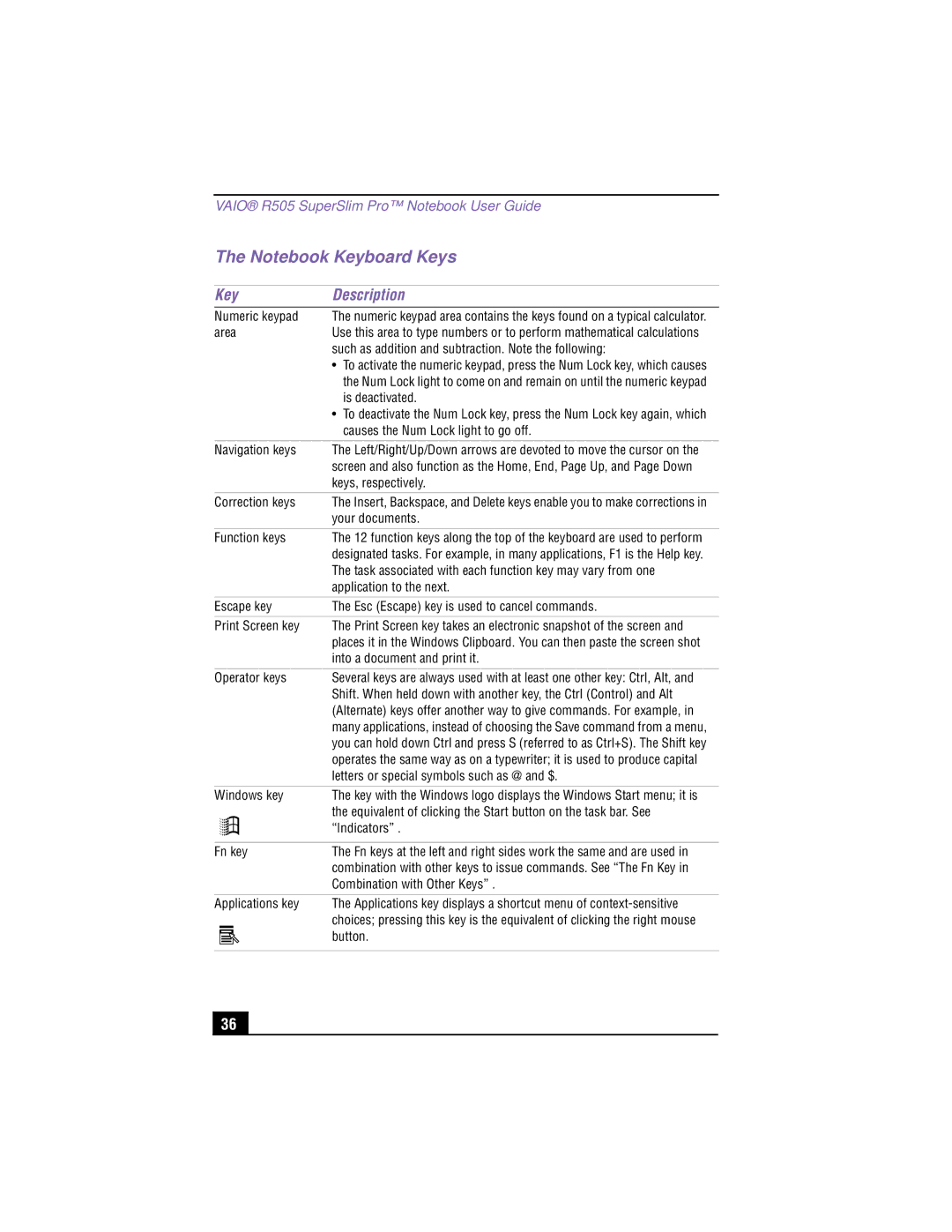
VAIO® R505 SuperSlim Pro™ Notebook User Guide
The Notebook Keyboard Keys
Key | Description | |||||
Numeric keypad | The numeric keypad area contains the keys found on a typical calculator. | |||||
area | Use this area to type numbers or to perform mathematical calculations | |||||
|
|
|
|
| such as addition and subtraction. Note the following: | |
|
|
|
|
| • | To activate the numeric keypad, press the Num Lock key, which causes |
|
|
|
|
|
| the Num Lock light to come on and remain on until the numeric keypad |
|
|
|
|
|
| is deactivated. |
|
|
|
|
| • | To deactivate the Num Lock key, press the Num Lock key again, which |
|
|
|
|
|
| causes the Num Lock light to go off. |
|
|
|
|
|
| |
Navigation keys | The Left/Right/Up/Down arrows are devoted to move the cursor on the | |||||
|
|
|
|
| screen and also function as the Home, End, Page Up, and Page Down | |
|
|
|
|
| keys, respectively. | |
|
|
|
|
|
| |
Correction keys | The Insert, Backspace, and Delete keys enable you to make corrections in | |||||
|
|
|
|
| your documents. | |
|
|
|
|
|
| |
Function keys | The 12 function keys along the top of the keyboard are used to perform | |||||
|
|
|
|
| designated tasks. For example, in many applications, F1 is the Help key. | |
|
|
|
|
| The task associated with each function key may vary from one | |
|
|
|
|
| application to the next. | |
|
|
|
|
|
| |
Escape key | The Esc (Escape) key is used to cancel commands. | |||||
|
|
|
|
|
| |
Print Screen key | The Print Screen key takes an electronic snapshot of the screen and | |||||
|
|
|
|
| places it in the Windows Clipboard. You can then paste the screen shot | |
|
|
|
|
| into a document and print it. | |
|
|
|
|
|
| |
Operator keys | Several keys are always used with at least one other key: Ctrl, Alt, and | |||||
|
|
|
|
| Shift. When held down with another key, the Ctrl (Control) and Alt | |
|
|
|
|
| (Alternate) keys offer another way to give commands. For example, in | |
|
|
|
|
| many applications, instead of choosing the Save command from a menu, | |
|
|
|
|
| you can hold down Ctrl and press S (referred to as Ctrl+S). The Shift key | |
|
|
|
|
| operates the same way as on a typewriter; it is used to produce capital | |
|
|
|
|
| letters or special symbols such as @ and $. | |
|
|
|
|
|
| |
Windows key | The key with the Windows logo displays the Windows Start menu; it is | |||||
|
|
|
|
| the equivalent of clicking the Start button on the task bar. See | |
|
|
|
|
| “Indicators” . | |
|
|
|
|
| ||
|
|
|
|
|
| |
Fn key | The Fn keys at the left and right sides work the same and are used in | |||||
|
|
|
|
| combination with other keys to issue commands. See “The Fn Key in | |
|
|
|
|
| Combination with Other Keys” . | |
|
|
|
|
|
| |
Applications key | The Applications key displays a shortcut menu of | |||||
|
|
|
|
| choices; pressing this key is the equivalent of clicking the right mouse | |
|
|
|
|
| button. | |
|
|
|
|
|
|
|
36
